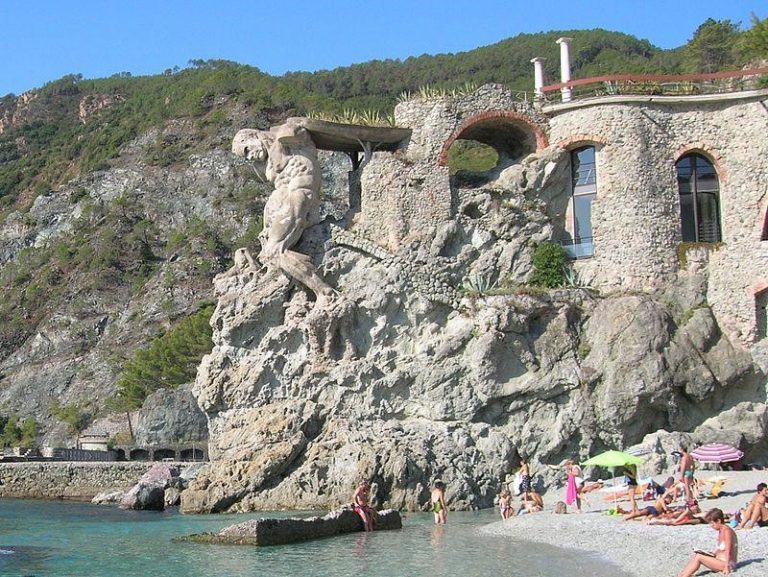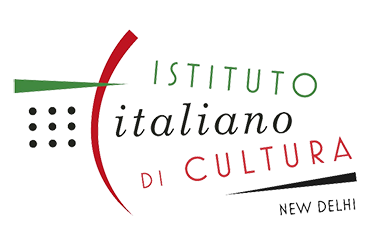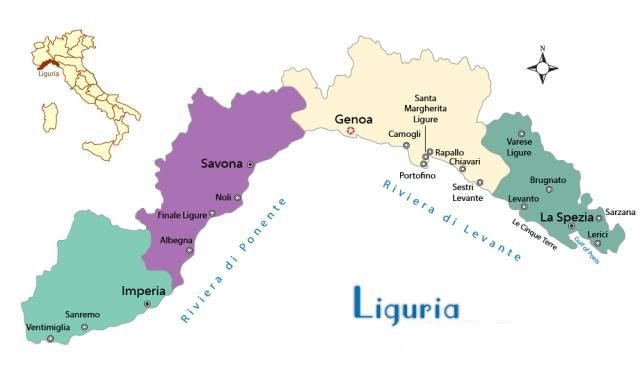Liguria: We will continue our tour of Liguria, visiting one of the most famous and photographed areas of the region
Liguria B
In this post we will continue our tour of Liguria, visiting one of the most famous and photographed areas of the region. We are talking about Cinque Terre (Five lands), a coastal and hilly strip of land in the Eastern side of Liguria.
The amazing landscapes and the harmonious relationship between human presence and nature in this area, brought Unesco to include Cinque Terre in the World Heritage list in 1997. It is a hugely touristic site, welcoming every year, mostly in summer, visitors from all over the world. The architecture of this region is characterized by the Genoa’s tower-houses, tall and thin buildings that are organized in parallel descending levels following the natural inclination of the hills. Their facades are usually painted in yellow, red and pink.

The five small towns that form the Cinque Terre are: Monterosso al Mare, Vernazza, Corniglia, Manarola, Riomaggiore. They are all connected by paths, railways and ferry lines, while moving by car in the area is not always easy. Cinque Terre is now part of a protected national Natural Park.
Monterosso
Let’s start from the first one you encounter coming from Genoa, Monterosso. It is the most populous town in Cinque Terre, and is the one with more road connections with the rest of Liguria. It is located at the center of a small natural gulf, and is divided by a promontory in two areas, Fegina and Old Harbour. In Fegina there is the train station, and many tourist and residential complexes.
The zone is also characterized by a big 14 meters high statue portraying the god Neptune built by the architect Francesco Levacher and the Sculptor Arrigo Minerbi in 1910. The area of Old Harbour is the historical center of Monterosso, where there is the biggest confluence of restaurants, wine bars and ice cream shops.

In Monterosso there is the largest beach of the whole Cinque Terre park. Not to miss the church of St. John the Baptist, built between 1282 and 1307. It is characterized by a facade in Gothic style, with white and dark horizontal stripes, and a big central rose window.
In the Capuchin hill, behind the town, is it possible to visit the church of Saint Francis and the attached monastery. Here is preserved an important art collection, which includes a painting of the famous Flemish artist Antoon Van Dyck, and pieces by Bernando Castello, Giuseppe Palmieri and Luca Cambiaso.

Vernazza
After Monterosso, it is now time to visit Vernazza. Also this town is characterized by a small promontory, which emerges from the coastline creating a beautiful bay with an amazingly blue color water. Thanks to its geographical position, Vernazza has been considered a safe harbour since the ancient times.

Similarly to all the locations in Cinque Terre, the streets in Vernazza are narrow and steep. They always follow the natural curving of the hills until the sea level. And almost in the water is located one of the symbols of the town, the church of Santa Margherita. It is a huge building, raised in the 14th Century on the remains of previous places of worship. It is characterized by an octagonal bell tower with two levels of arches and a pointed shape dome.

On the opposite side of the bay are located the Doria Castle and the Belforte tower. The Castle is a medieval fortress built on the top of a 80 meters high promontory. Notes about its presence in the town date back to the 11th Century. The Belforte tower is a cilindric structure used in the past for military and sighting purposes, while now the complex is a venue for art and historic exhibitions.

Trekking lovers will find many trail opportunities starting from Vernazza. One of them leads through a 2 kilometers submerged in nature to the Sanctuary of Nostra Signora di Reggio. The path is gorgeous, and gives the opportunity to see ancient trees, like an 800 years old cypress.
Corniglia
Corniglia is the central town in Cinque Terre, and the only one that doesn’t overlook the sea. In fact, it is located on the top of a 100 meters tall promontory, surrounded by vineyards organized with the typical terrace modality. And not having an harbour, the economy of the town has always been based on the production of grapes and wines. A gorgeous path at mid-height between the peak and the sealine connects Corniglia with Vernazza.

To arrive at the center of the town from the train station there is a charming stair with 370 steps. It is a bit steep, but the views are really suggestive. Anyway, there is also a convenient bus for the ones who prefer not to climb the stairs.

In Corniglia’s main square is it possible to visit the Baroque style Saint Peter church. Its main feature is a beautiful rose window realized in Carrara marble. On the 29th of June, for Saint Peter day, in the town is organized a beautiful fair where it is possible to attend concerts and shows, and to try all the amazing local products.
In the small square Largo Taragli there is an oratory dedicated to Santa Caterina, dating back to the 18th Century. It is a simple, little church, located in an amazing position. In fact, from the square in front of the building is it possible to enjoy an amazing view of the blue sea.

Corniglia is also one of the best places in Cinque Terre for the lovers of beaches and sunbathing. There are two amazing locations reachable from the town. The first is the beach of Guvano, where it is possible to arrive through a 377 steps stair. But the result is totally worth the effort, as you will find a beautiful rocky beach, with a blue crystal clear water.

There is also a much easily reachable beach, only a few meters away from the train station. Here the natural landscape is characterized by big white rocks. This is also the starting point of a footpath which leads directly to the town of Manarola.
Manarola
Let’s start our visit to Manarola, the smallest town in Cinque Terre after Corniglia. Its urban plant developed in the gorge created by the creek Groppo, that has now been covered in its final section. Manarola’s main road, via Discovolo, follows the old stream path, and for this reason the habitants of the town call it the ‘Canal’.

Via Belvedere, which from the little harbour leads to the square Eugenio Montale, is the right place to enjoy an amazing view of the town and of the sea.
The church of San Lorenzo is the main place of worship of the town. It’s facade was built with sandstone in Ligurian Gothic style, while the interior decoration is Baroque. Over the centuries, its tall bell tower has also served a function of post for the sighting of pirate vessels.

Manarola is also famous for one of the biggest nativity scenes in the whole world. Mario Andreoli, former employee of the Italian Railways, builds every year a huge representation of the crib, with more than 300 life-sized characters. The scene is lit every night during the Christmas holidays, providing an astonishing and heartwarming experience. The installation requires more than 8 km of electric wires, and 17.000 lamps.

The beach of Manarola is small and rocky, but the water is simply amazing. Despite the access to the sea not being super comfortable, the experience of having a bath just below the beautiful landscape of Manarola’s colorful houses is totally worthy.
From Manarola starts a famous hiking trail, called Via dell’Amore (Love’s trail). It is a fantastic way to reach Riomaggiore, walking between the romantic atmosphere of the hills and the vineyards above the town. It takes just 20 minutes to complete the lane, and go from one town to the other.

Riomaggiore
Riomaggiore is the Eastern town in Cinque Terre. It was founded in the valley of the ancient river Rivus Major, from which it takes its name. Probably its original inhabitants were moving from the Vara valley, in the search for a better weather ideal for the plantations of grapevines and olive trees. Its landscape is characterized by many parallel levels of tower-houses, which follow the steep bed of the river down to the sea.

The main road of Riomaggiore is called via Colombo, and is filled with nice bars, restaurants and shops.
In the higher part of the town it is located the church of St. John the Baptist, patron saint of Riomaggiore. It dates back to 1340, and its interior preserves a beautiful colonnade and a rose-window.

Worth a visit is the Castle. Built in the 13th Century by the marquis Turcotti to protect the population from the continuous attacks of the pirates, from the top it is possible to enjoy an amazing view of the hills covered with vineyards from one side, and of the narrow alleys of Riomaggiore and of the sea from the other. Over the centuries the complex has served also as cemetery, while now it belongs to the Town Hall, which uses it for conferences and art exhibitions.

Gastronomy

Seafood is one of the main protagonists of the local gastronomy, and it couldn’t be otherwise thanks to its location. For example, the anchovies of Monterosso are a fantastic product that has received the status of Protected Designation of Origin from the European Union. Or the stuffed mussels, filled with breadcrumbs, garlic, persley, eggs and parmigiano.
A typical dish for outdoor activities or a day at the beach is the ‘Torta di Riso’. It is a sauvery cake, filled with boiled rice, eggs, parmigiano reggiano and nutmeg. In the filling can be added vegetables, mushrooms, or tomato sauce, and it can be served both warm or cold.

The region is also famous for its wines. The grapes cultivated are mainly the Bosco, Albarola and Vermentino varieties, used for the wines Cinque Terre and Sciachetrà. Another typical product of the area is Grappa. It is a liquor made from the pomace of the grapes, originally introduced as a way to avoid the wastes from the process of winemaking.

As for dessert, a typical cake that must be tasted is the Monterossina. Made with shortcrust pastry, apricot jam, creme patissiere and dark chocolate, it is a pleasure for the palate. While in Corniglia it is possible to eat a fantastic local ice cream, made with honey produced in the area.
Then, also here are widely common the other dishes of the Liguria’s traditional cuisine, like farinata, focaccia and of course, fresh pasta with pesto.

